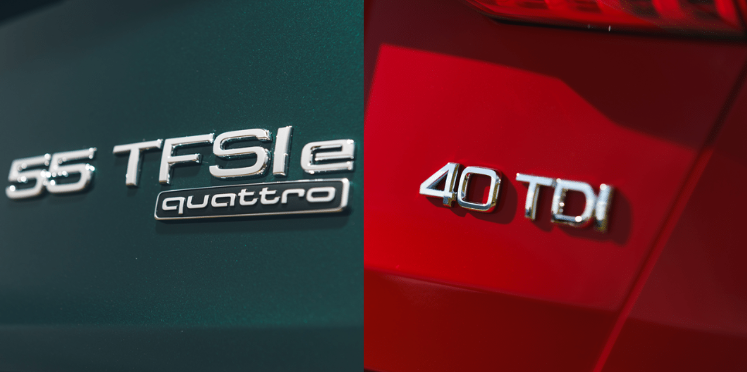Since the end of 2017 Audi has adopted a new way of badging its models, which is based on the power output.
If you haven’t noticed this on the back of an Audi before, it essentially means that the size of the engine is no longer displayed. This ‘litre’ badging – e.g ‘2.0’ – is replaced by a number ranging between 25 and 70, with that number referencing the power output.
It might seem a confusing system, but this has been implemented to make it easier for buyers to cross reference the power output of electric and plug-in hybrid cars with conventional petrol and diesel models.
So, how does it work?
As we’ve mentioned the number badges varies from 25 to 70, depending on the power output, with the number rising in increments of five. The smaller the number, the less power it has, meaning higher numbers have more power. For each number, there is a range of outputs, so if it’s a ’30 TFSI’ that means it can have between 108bhp and 129bhp, for example.
There is then the fuel designation. So, if it says TFSI that means it’s a petrol, while TDI equates to a diesel engine. If you’re looking for a plug-in hybrid it will be badged as a ‘TFSI e’, while all-electric models are labelled as ‘e-tron’.

Now time to explain what that number means in terms of power. The number on the left is what the car is badged as, along with the power outputs that relates to.
Please note that ‘RS’, ‘R’ and ‘S’ models do not feature this branding, while if you’re not a fan of the badging, you can have it deleted from the factory.
- 25 (TFSI/TDI/TFSI e/e-tron) – Under 108bhp
- 30: 108bhp – 129bhp
- 35: 148bhp – 161bhp
- 40: 168bhp – 202bhp
- 45: 227bhp – 247bhp
- 50: 281bhp – 309bhp
- 55: 328bhp – 370bhp
- 60: 429bhp – 457bhp
- 70: 522bhp plus